LD Capital: Analysis of the POW public chain Kaspa based on the GHOSTDAG protocol
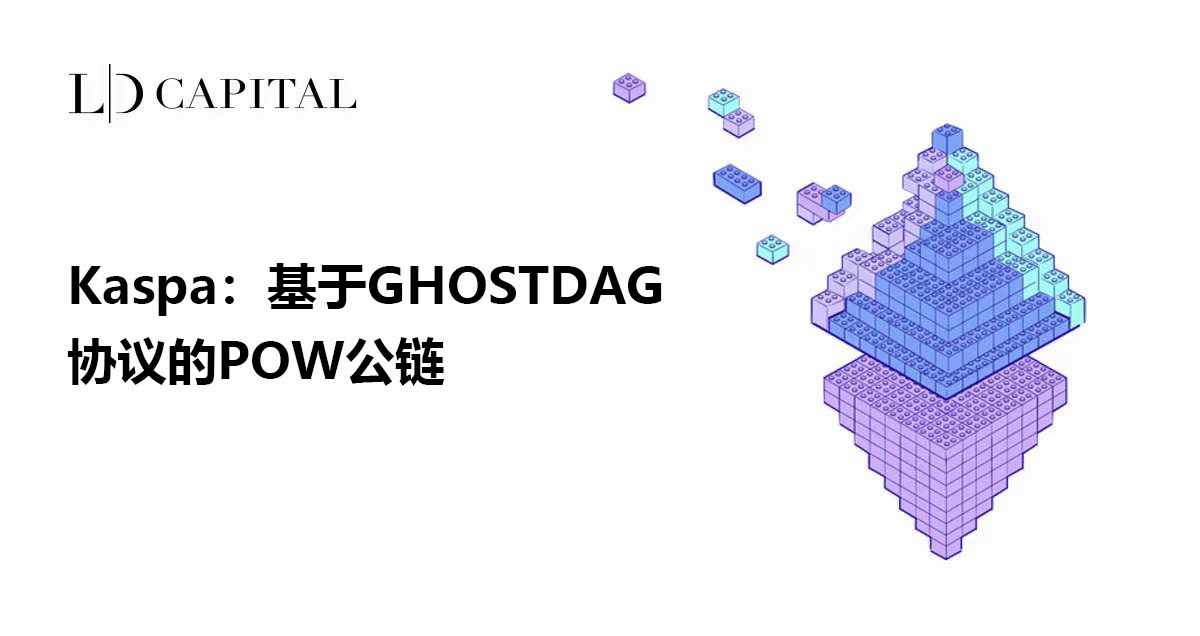
Author: duoduo, LD Capital
Kaspa is a POW public chain built on the GHOSTDAG protocol. Compared to Bitcoin, Kaspa mainly changes the structure pattern of the blockchain. Bitcoin adopts a single chain structure, while GHOSTDAG adopts a directed acyclic graph (DAG) structure, where one block can point to multiple blocks.
The token KAS was launched in November 2021, with a total supply of 28.7 billion and a circulating supply of 19.8 billion, accounting for 69% of the circulation. Its market value is 750 million USD with a FDV of 1.08 billion USD. Since the token was launched, its value has increased by hundreds of times.
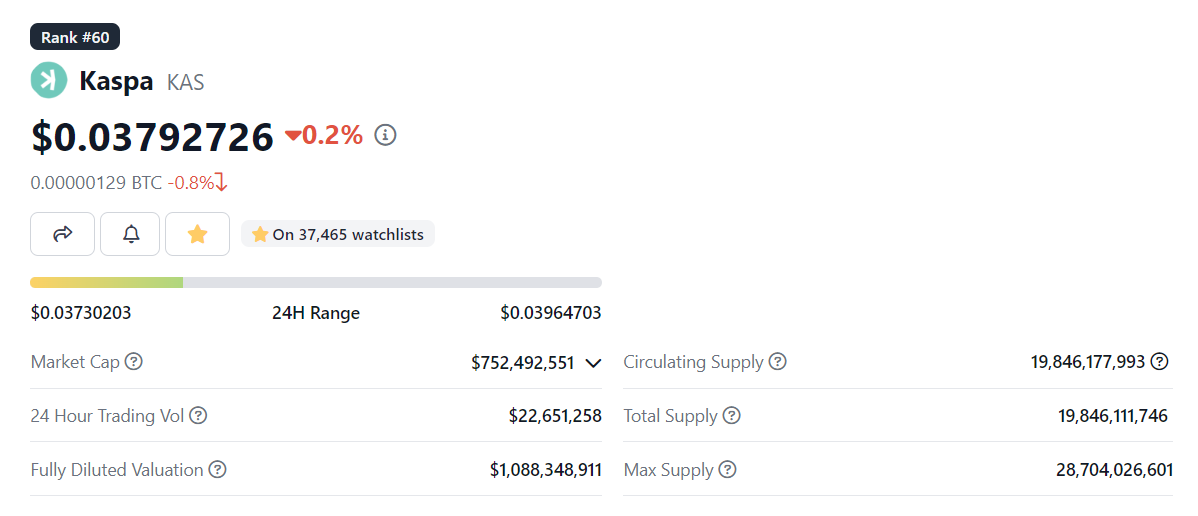
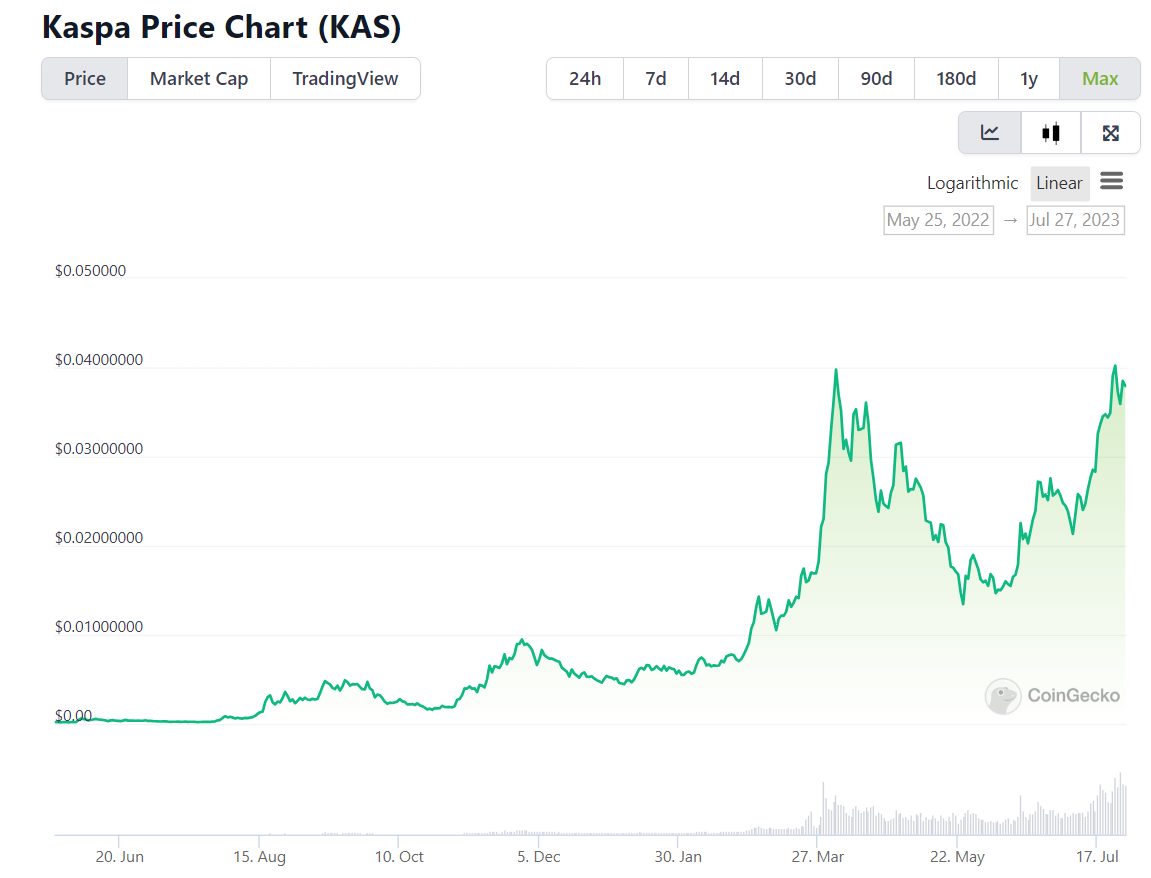
1. Team
Kaspa's team has a certain reputation. The founder, Yonatan Sompolinsky, is currently a postdoctoral fellow at Harvard University, specializing in transaction ordering and MEV. As early as 2013, he and his then doctoral advisor conceived the GHOST protocol, and related papers were cited in the Ethereum whitepaper.
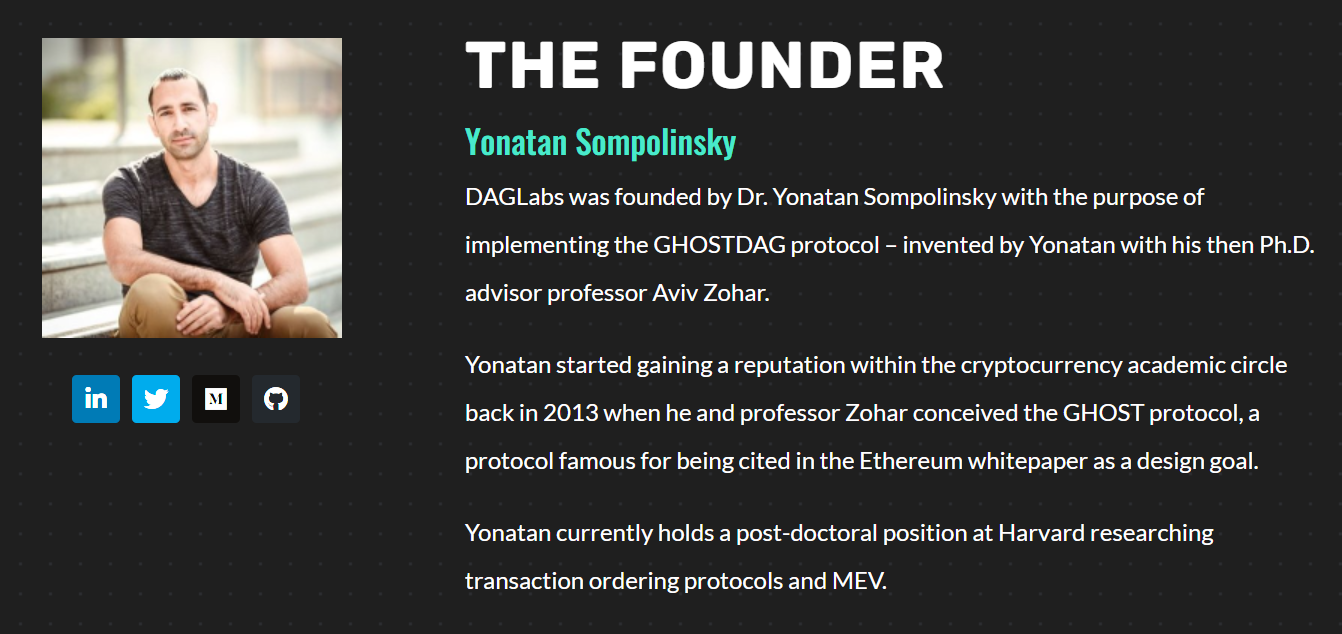
Source: Kaspa official website
The following is a part of the content quoted from the Ethereum whitepaper:
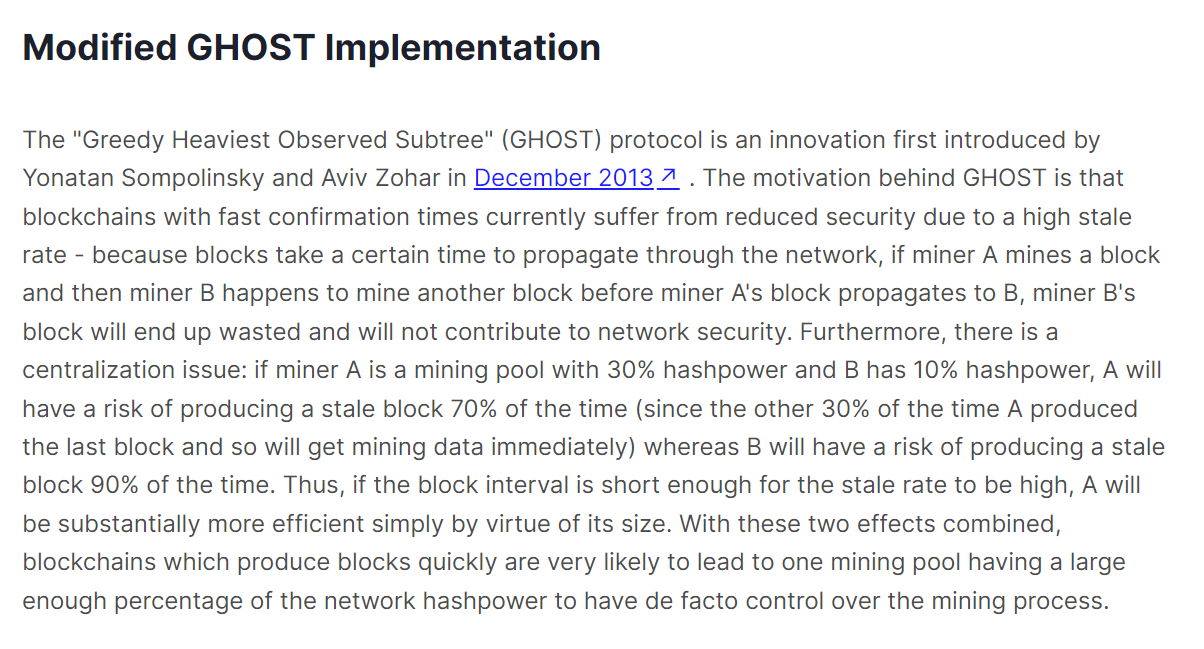
Source: Ethereum Whitepaper
In addition to the founder, there are 5 core developers. Michael Sutton researches parallel algorithms and distributed systems. Shai Wyborski is one of the authors of the GHOSTDAG paper and researches classical and quantum cryptography. Mike Zak and Ori Newman research distributed system development. Elichai Turkel is an applied cryptographer and a high-performance open blockchain personnel.


Source: Kaspa Official Website
II. Technical Principles
The technical principles of Kaspa are mainly discussed in its 2021 paper "PHANTOM GHOSTDAG: A Scalable Generalization of Nakamoto Consensus".
Bitcoin is essentially an open and anonymous node network that maintains a public transaction ledger. The ledger adopts the "longest chain" principle to connect honest blocks to each other and protect the security of the network. This design artificially restricts the throughput of the network, resulting in low protocol scalability. Currently, the Bitcoin network produces one block every 10 minutes, with a transaction throughput of 3-7 transactions per second.
Structural Model: Directed Acyclic Graph (DAG) Structure
Kaspa proposed the PHANTOM protocol, which is a permissionless ledger protocol based on proof-of-work, and extends the blockchain defined by Satoshi Nakamoto to a directed acyclic graph (blockDAG). PHANTOM can reference multiple previous blocks, provides a total ordering of all blocks and transactions, and outputs a set of consistent and accepted transactions.
PHANTOM includes a parameter k, which controls the protocol's tolerance for concurrently created blocks, and can be set to accommodate higher throughput. When k=0, it means no forks, similar to Bitcoin's single chain, longest chain structure.
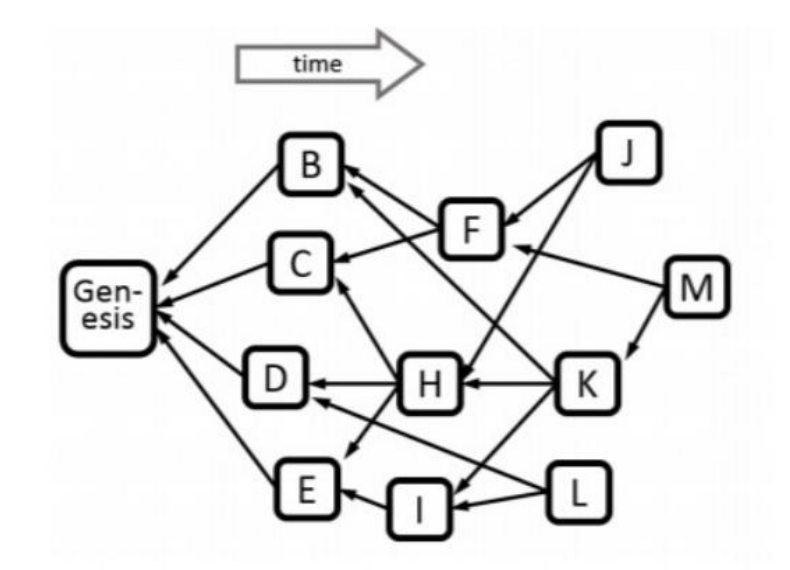
Source:"PHANTOM GHOSTDAG: A Scalable Generalization of Nakamoto Consensus"
Let's first understand several different types of blocks in DAG. The corresponding concepts will be used in the examples below. In the figure above, take block H as an example:
past(H)={Genesis, C, D, E} — — the past blocks that directly or indirectly point to block H before its creation;
future(H)={J, K, M} — — the future blocks that directly or indirectly point to block H after its creation;
anticone(H)={B, F, G} — — the blocks that are not in the future of block H;
I, L} - Blocks other than the past(H) and future(H) have no direct or indirect relationship with H;
tips(G)={J, L, M} - Leaf or terminal blocks, these blocks will be referenced by the block header of the new block.
Identifying honest blocks and malicious blocks
PHANTOM solves the problem of identifying honest blocks and malicious blocks. Malicious attacks have one characteristic: the connectivity between blocks generated by malicious nodes and blocks generated by honest nodes is low, while the connectivity between blocks generated by honest nodes is high.
The criterion for judgment is the parameter K value mentioned above. For a specific block X, if the intersection of anticone(X) and honest blocks is higher than the k value, it means that the connectivity between block X and honest blocks is low, and X will be judged as an attack block; otherwise, it indicates that the connectivity between X and honest blocks is high, and X is considered an honest block.
The following figure shows the honest blocks and attack blocks.
Judge. The value of K here is 3. After inspection, the blue part is the honest block, and the red part is the attacking block.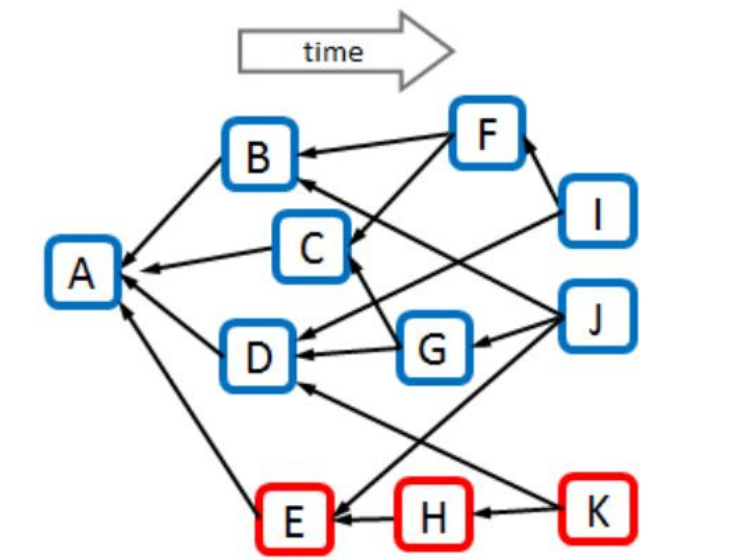
Source:"PHANTOM GHOSTDAG: A Scalable Generalization of Nakamoto Consensus"
Linear Sorting
To resolve the double-spending problem, the project team applied the GHOSTDAG protocol. The principle is to score each block based on its connectivity (the number of elements in the past block set) and choose the block with the highest total score to form the main chain, which forms an initial subset. The remaining blocks will vote in the order of the main chain. The entire network will vote in a trend from high to low connectivity.
The following image shows how GHOSTDAG completes the sorting process with parameter K=3. The small circles on each block X represent its score, which is the number of blue blocks in the past DAG.
In Step 1, starting from the block M with the highest score, select blocks K, ...
, and Genesis block, are marked with blue background and black border, forming the initial subset. Access block , the past blocks of D only have Genesis block.Step 2, access block , the past blocks of H include C, D, E. After identifying honest blocks and attack blocks according to the aforementioned method, C, D, E are considered honest blocks and added to the subset, marked with blue border.
Step 3, access block , the past blocks of K include H, I. After identification, both H and I are considered honest blocks, marked with blue border.
Step 4, access block , the past blocks of M include K, F. K is considered an honest block, added to the subset, marked with blue border.
Step 5, block is a virtual block, and its past is the entire current DAG.
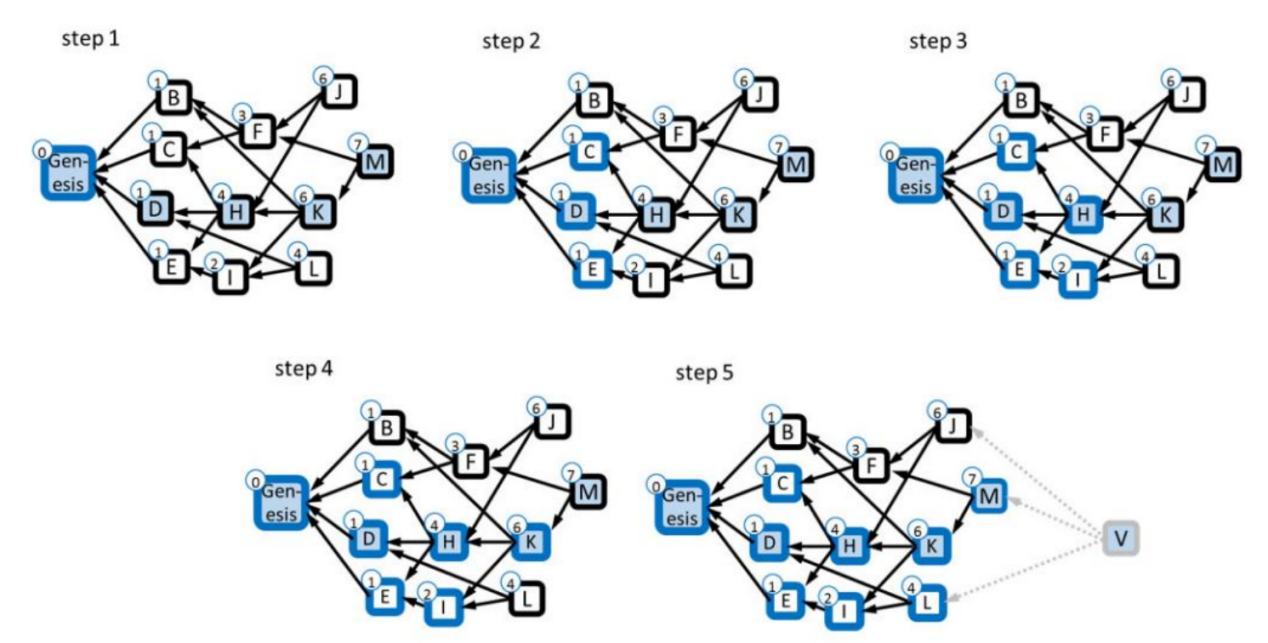
Source: "PHANTOM GHOSTDAG: A Scalable Generalization of Nakamoto Consensus"
So far, Kaspa has completed the discussion on the new consensus architecture and is being used in practice. The official website shows the visualization process of the DAG:
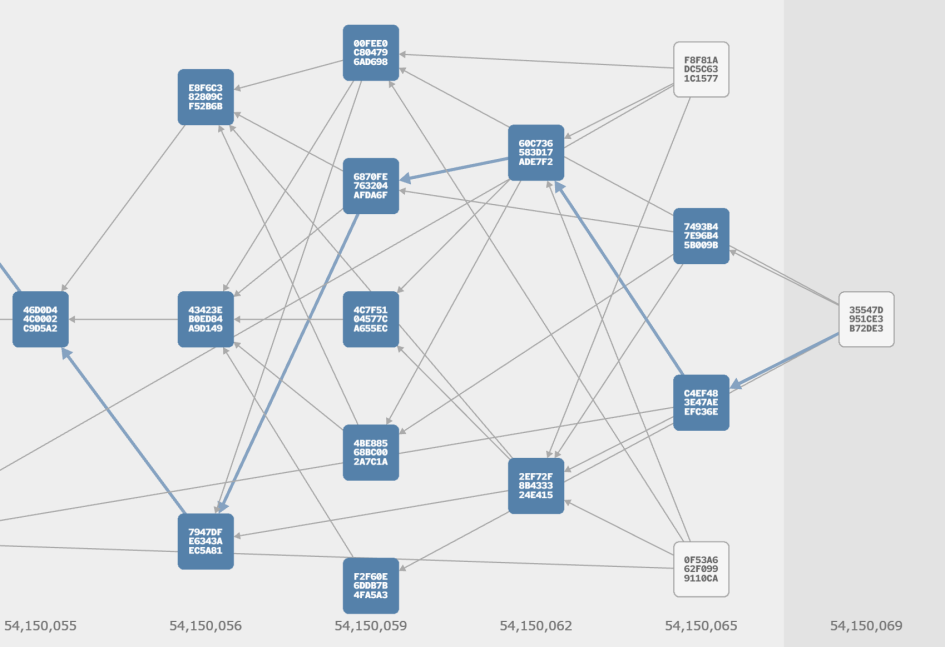
Source: Kaspa Official Website
3. Mining Power Status
Kaspa mining algorithm is kHeavyHash, which supports GPU solo mining or dual mining with ETHW and ETC, as well as partial FPGA and ASIC mining machines.
According to the official blockchain explorer, Kaspa's mining power is 2.6 - 2.7 PH/s. According to Mining Pool data, Kaspa's mining power ranks around 30th, after BCH, BSV, DASH, and before DOGE, LTC.
Kaspa's mining power shows a continuous growth trend. In October 2022, and December 2022sp;In February, 2023, July 2023, there were four significant increases in computing power. In March of this year, mining equipment manufacturers introduced professional miners to improve mining efficiency for miners.
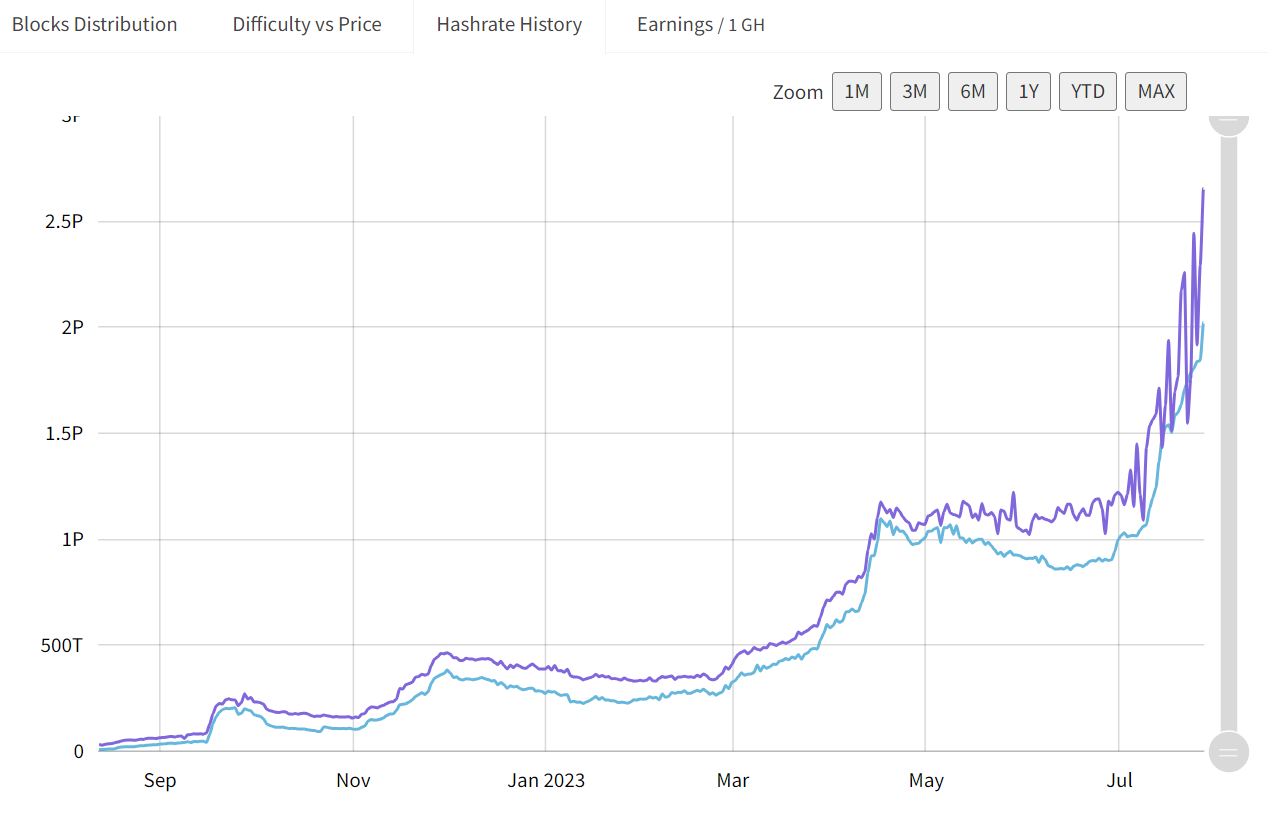
Source: miningpoolstats
From the perspective of computing power distribution, the concentration of computing power is not too high. In the latest 999 blocks, the top five mining pools accounted for 37.1% of the output; over 56.7% of the blockchain was produced by unmarked addresses.
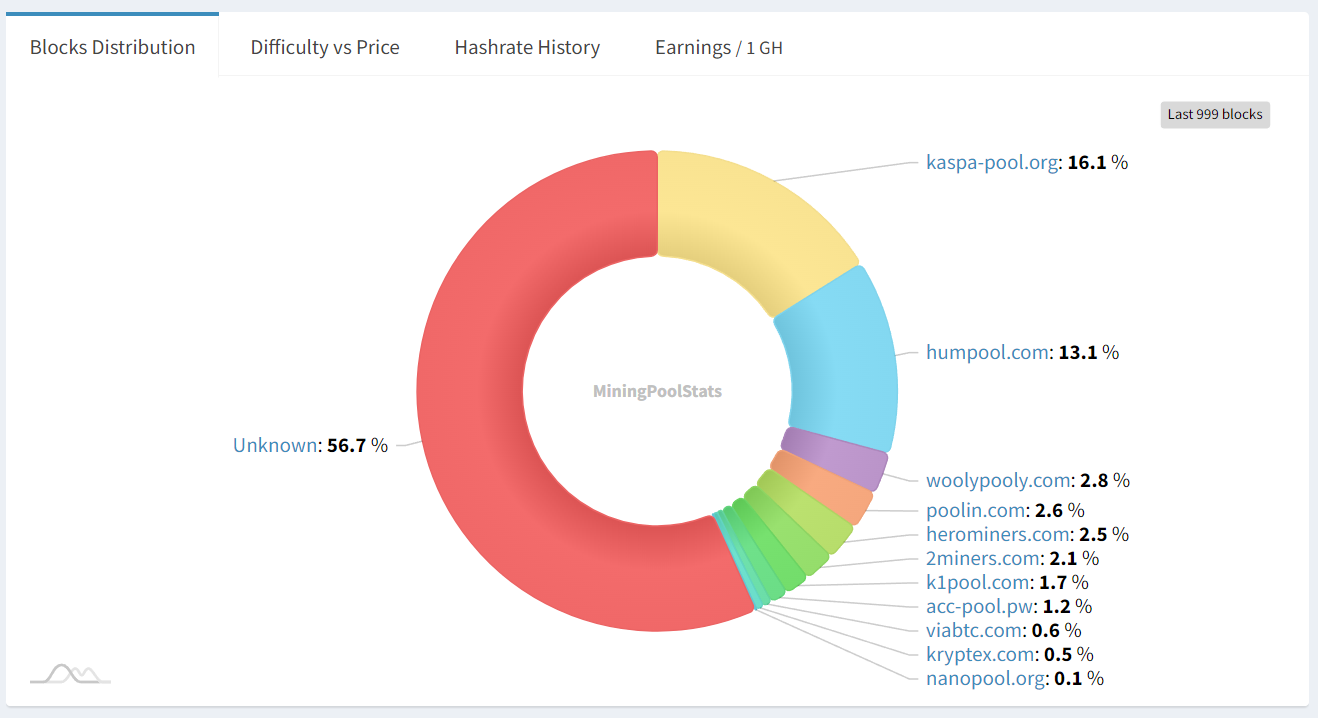
Source: miningpoolstats
IV. Token Economic Model
Token Distribution
KAS, launched in November 2021, has no pre-mining, no pre-sale, and no token distribution. The total supply is 28.7 billion coins, with a circulating supply of 19.8 billion coins, accounting for 69% of the total, with a market value of $750 million and a FDV of $1.08 billion.
Token Release
According to the emission plan, KAS reduces its output every month in a given manner, resulting in a halving of the output each year. The following diagram illustrates the token release, showing higher release rates in the early stages, allowing early miners to accumulate a large number of chips. The specific release schedule can be found on the official website (https://kaspa.org/wp-content/uploads/2022/09/KASPA-EMISSION-SCHEDULE.pdf.
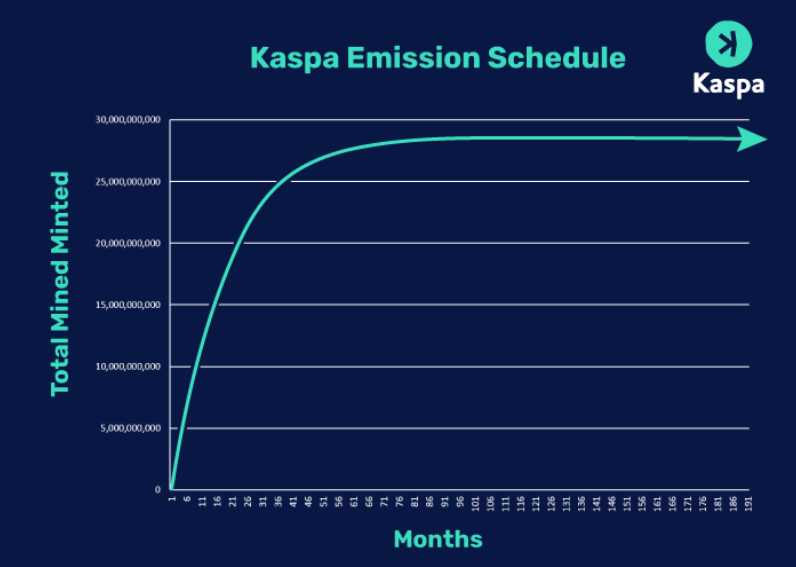
According to the token emission table, the monthly emission volume and release value of KAS tokens from July 2023 to June 2024 were calculated as shown in the table below. If calculated at a price of 0.037, in July 2023, KAS will emit tokens worth $19 million, gradually decreasing thereafter; by June 2024, the emission value will be approximately $10 million.
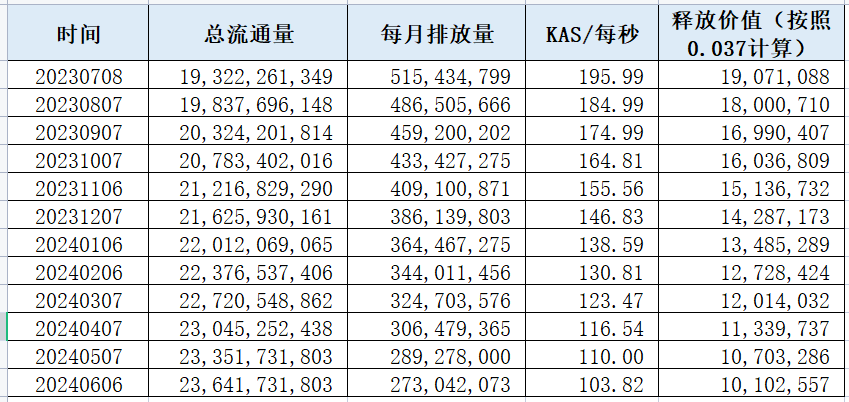
Source: Kaspa Official Website, LD Capital
According to the data from f2pool, Kaspa is currently ranked fourth in terms of 24-hour output value, only behind Bitcoin, Dogecoin, and Litecoin, but higher than ETC and BCH.
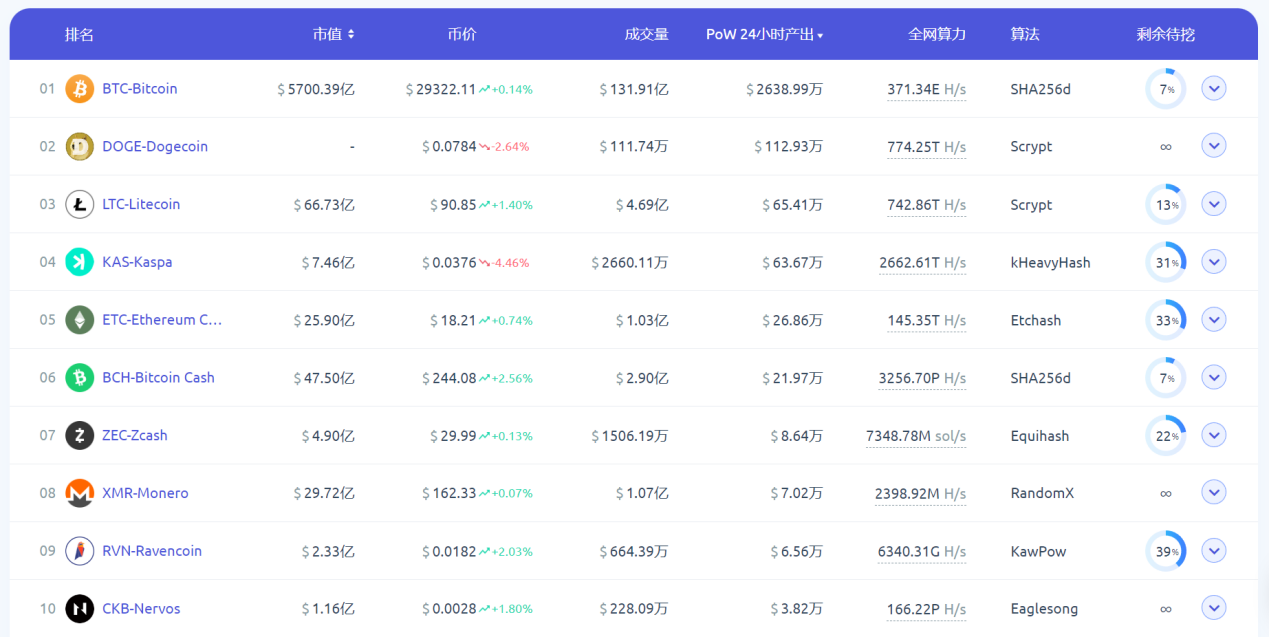
Source: f 2 pool
Holdings
There are a total of 26.7 thousand addresses holding 1 or more KAS tokens. The token distribution is also relatively concentrated, with the top 10 addresses holding 17.299% of the tokens, mainly in exchange wallets. The top 100 addresses hold 26.13% and the top 1000 addresses hold 61.35%.
Looking at the token flow, in the past 30 days, addresses holding 100-10K tokens have seen a decrease in holdings, while addresses holding 0-100 tokens and 10K or more tokens have seen an increase. In the past 7 days, addresses holding 100-10K tokens and addresses holding 100M to 1B Humpback tokens have seen a decrease in holdings, while other addresses have seen an increase.
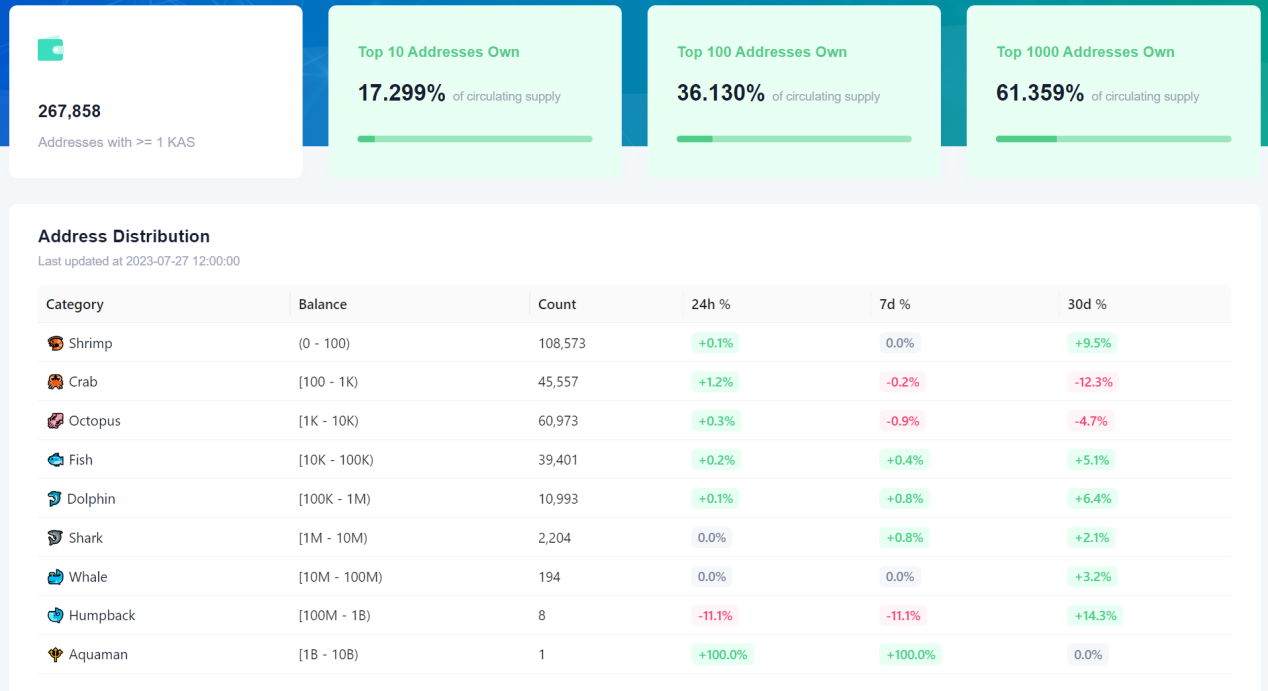
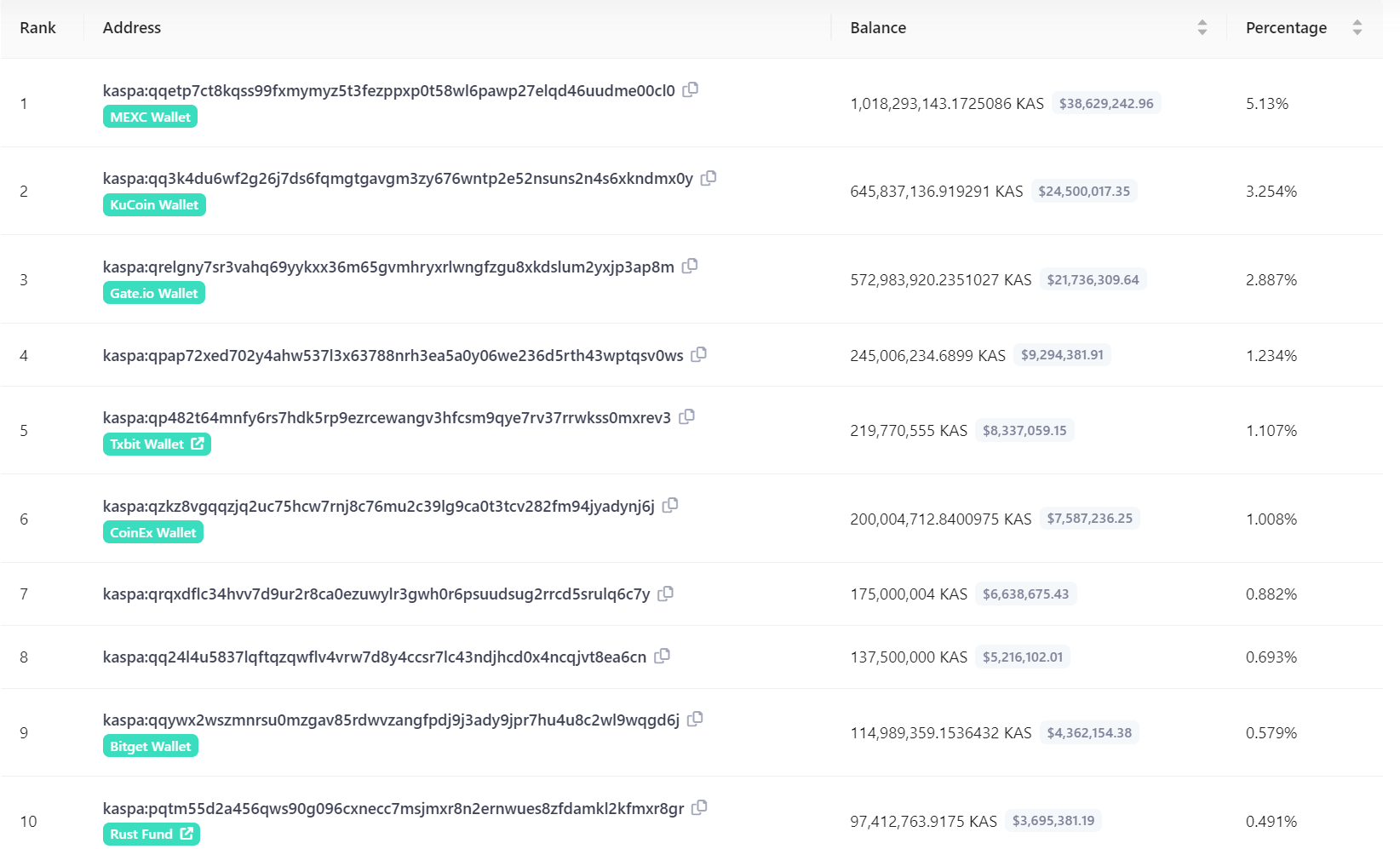
Source: Kaspa Blockchain Explorer
5. Current Progress and Development Plans
The official website has disclosed some important progress and recent development plans since 2023.
Completed
In February 2023, project core developer Michael Sutton published a paper on DagKnight Consensus, an evolution of GHOSTDAG consensus mechanism that theoretically lays the foundation for faster transactions and confirmations.
Currently in Testing
Rewrite code using Rust programming language
Currently, Kaspa is written in GoLang programming language. Michael Sutton is rewriting the code using the Rust programming language, which will improve Kaspa's performance and transaction speed.
Mobile wallet development
There is a strong demand for high-performance mobile wallets from users, and the development is expected to take 3-4 months.
Integrate Kaspa on Ledger
Users can use the Ledger hardware wallet to send and receive KAS.
In Development
Upgrade consensus mechanism according to DagKnight Consensus
Further increase the number of blocks per second and the number of transactions per second
Currently, Kaspa produces 1 block per second, with the goal of increasing it to 32 blocks per second. The current testnet can achieve a production of 10 blocks per second.
Release project whitepaper
There are several research papers on Kaspa's technology, but the official project whitepaper has not been released yet and is being organized.
Improving Archive Nodes
Currently, Kaspa's standard nodes can only access transactions from three days ago. By improving archive nodes, more historical data can be retrieved.
Development Plan
Implement smart contracts and establish an ecosystem
Kaspa aims to achieve smart contracts, Defi, and Layer 2 applications on its public chain and build the corresponding ecosystem.
The development and deployment of smart contracts are vital factors for its further development. If smart contracts can be deployed in a timely and smooth manner, and an ecosystem with a certain level of activity can be established, Kaspa's market value still has room for further growth. However, if the deployment of smart contracts encounters difficulties and the ecosystem fails to develop, there will be noticeable bottlenecks in future development.
Summary
The project team has strong technical capabilities and a good development foundation. They have proposed a new blockchain model and explored new development directions. They have also gained mining power transferred from Ethereum in the early stages and have seen a continuous increase in mining power.
The market value is high and has risen more than a hundredfold. Currently, KAS market value is 7.5&nbs;
Billions of dollars, ranking around 60th, the market has already fully valued the technical team and computing power growth. Future growth will require stronger expectations to support it.
There is a potential selling pressure for tokens. Early miners hold a large number of low-priced chips, and there is also continuous daily output. If sold, it will cause significant price impact.
Step 2, access block
Step 3, access block
Step 4, access block
Step 5, block

Source: "PHANTOM GHOSTDAG: A Scalable Generalization of Nakamoto Consensus"
So far, Kaspa has completed the discussion on the new consensus architecture and is being used in practice. The official website shows the visualization process of the DAG:

Source: Kaspa Official Website
3. Mining Power Status
Kaspa mining algorithm is kHeavyHash, which supports GPU solo mining or dual mining with ETHW and ETC, as well as partial FPGA and ASIC mining machines.
According to the official blockchain explorer, Kaspa's mining power is 2.6 - 2.7 PH/s. According to Mining Pool data, Kaspa's mining power ranks around 30th, after BCH, BSV, DASH, and before DOGE, LTC.
Kaspa's mining power shows a continuous growth trend. In October 2022, and December 2022sp;In February, 2023, July 2023, there were four significant increases in computing power. In March of this year, mining equipment manufacturers introduced professional miners to improve mining efficiency for miners.

Source: miningpoolstats
From the perspective of computing power distribution, the concentration of computing power is not too high. In the latest 999 blocks, the top five mining pools accounted for 37.1% of the output; over 56.7% of the blockchain was produced by unmarked addresses.

Source: miningpoolstats
IV. Token Economic Model
Token Distribution
KAS, launched in November 2021, has no pre-mining, no pre-sale, and no token distribution. The total supply is 28.7 billion coins, with a circulating supply of 19.8 billion coins, accounting for 69% of the total, with a market value of $750 million and a FDV of $1.08 billion.
Token Release
According to the emission plan, KAS reduces its output every month in a given manner, resulting in a halving of the output each year. The following diagram illustrates the token release, showing higher release rates in the early stages, allowing early miners to accumulate a large number of chips. The specific release schedule can be found on the official website (https://kaspa.org/wp-content/uploads/2022/09/KASPA-EMISSION-SCHEDULE.pdf.

According to the token emission table, the monthly emission volume and release value of KAS tokens from July 2023 to June 2024 were calculated as shown in the table below. If calculated at a price of 0.037, in July 2023, KAS will emit tokens worth $19 million, gradually decreasing thereafter; by June 2024, the emission value will be approximately $10 million.

Source: Kaspa Official Website, LD Capital
According to the data from f2pool, Kaspa is currently ranked fourth in terms of 24-hour output value, only behind Bitcoin, Dogecoin, and Litecoin, but higher than ETC and BCH.

Source: f 2 pool
Holdings
There are a total of 26.7 thousand addresses holding 1 or more KAS tokens. The token distribution is also relatively concentrated, with the top 10 addresses holding 17.299% of the tokens, mainly in exchange wallets. The top 100 addresses hold 26.13% and the top 1000 addresses hold 61.35%.
Looking at the token flow, in the past 30 days, addresses holding 100-10K tokens have seen a decrease in holdings, while addresses holding 0-100 tokens and 10K or more tokens have seen an increase. In the past 7 days, addresses holding 100-10K tokens and addresses holding 100M to 1B Humpback tokens have seen a decrease in holdings, while other addresses have seen an increase.


Source: Kaspa Blockchain Explorer
5. Current Progress and Development Plans
The official website has disclosed some important progress and recent development plans since 2023.
Completed
In February 2023, project core developer Michael Sutton published a paper on DagKnight Consensus, an evolution of GHOSTDAG consensus mechanism that theoretically lays the foundation for faster transactions and confirmations.
Currently in Testing
Rewrite code using Rust programming language
Currently, Kaspa is written in GoLang programming language. Michael Sutton is rewriting the code using the Rust programming language, which will improve Kaspa's performance and transaction speed.
Mobile wallet development
There is a strong demand for high-performance mobile wallets from users, and the development is expected to take 3-4 months.
Integrate Kaspa on Ledger
Users can use the Ledger hardware wallet to send and receive KAS.
In Development
Upgrade consensus mechanism according to DagKnight Consensus
Further increase the number of blocks per second and the number of transactions per second
Currently, Kaspa produces 1 block per second, with the goal of increasing it to 32 blocks per second. The current testnet can achieve a production of 10 blocks per second.
Release project whitepaper
There are several research papers on Kaspa's technology, but the official project whitepaper has not been released yet and is being organized.
Improving Archive Nodes
Currently, Kaspa's standard nodes can only access transactions from three days ago. By improving archive nodes, more historical data can be retrieved.
Development Plan
Implement smart contracts and establish an ecosystem
Kaspa aims to achieve smart contracts, Defi, and Layer 2 applications on its public chain and build the corresponding ecosystem.
The development and deployment of smart contracts are vital factors for its further development. If smart contracts can be deployed in a timely and smooth manner, and an ecosystem with a certain level of activity can be established, Kaspa's market value still has room for further growth. However, if the deployment of smart contracts encounters difficulties and the ecosystem fails to develop, there will be noticeable bottlenecks in future development.
Summary
The project team has strong technical capabilities and a good development foundation. They have proposed a new blockchain model and explored new development directions. They have also gained mining power transferred from Ethereum in the early stages and have seen a continuous increase in mining power.
The market value is high and has risen more than a hundredfold. Currently, KAS market value is 7.5&nbs;
Billions of dollars, ranking around 60th, the market has already fully valued the technical team and computing power growth. Future growth will require stronger expectations to support it.
There is a potential selling pressure for tokens. Early miners hold a large number of low-priced chips, and there is also continuous daily output. If sold, it will cause significant price impact.



